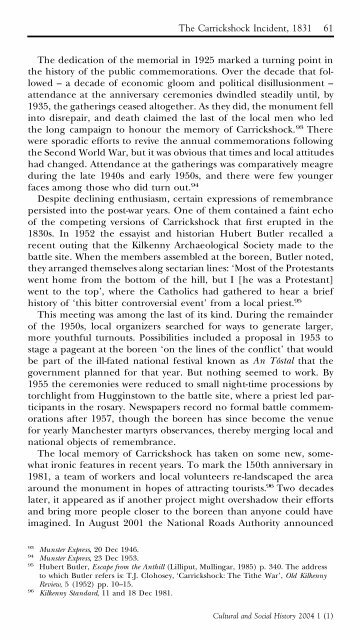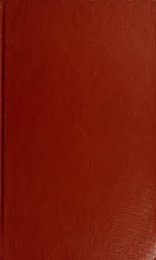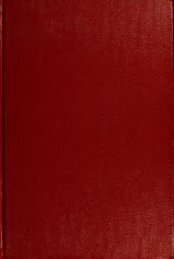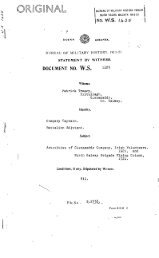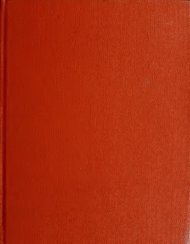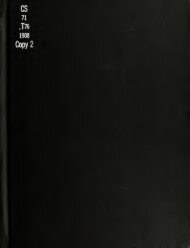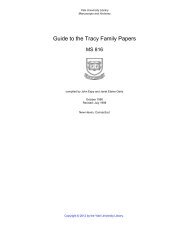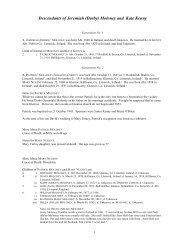The Carrickshock Incident, 1831: Social Memory and an Irish cause ...
The Carrickshock Incident, 1831: Social Memory and an Irish cause ...
The Carrickshock Incident, 1831: Social Memory and an Irish cause ...
You also want an ePaper? Increase the reach of your titles
YUMPU automatically turns print PDFs into web optimized ePapers that Google loves.
<strong>The</strong> <strong>Carrickshock</strong> <strong>Incident</strong>, <strong>1831</strong> 61<br />
<strong>The</strong> dedication of the memorial in 1925 marked a turning point in<br />
the history of the public commemorations. Over the decade that followed<br />
– a decade of economic gloom <strong><strong>an</strong>d</strong> political disillusionment –<br />
attend<strong>an</strong>ce at the <strong>an</strong>niversary ceremonies dwindled steadily until, by<br />
1935, the gatherings ceased altogether. As they did, the monument fell<br />
into disrepair, <strong><strong>an</strong>d</strong> death claimed the last of the local men who led<br />
the long campaign to honour the memory of <strong>Carrickshock</strong>. 93 <strong>The</strong>re<br />
were sporadic efforts to revive the <strong>an</strong>nual commemorations following<br />
the Second World War, but it was obvious that times <strong><strong>an</strong>d</strong> local attitudes<br />
had ch<strong>an</strong>ged. Attend<strong>an</strong>ce at the gatherings was comparatively meagre<br />
during the late 1940s <strong><strong>an</strong>d</strong> early 1950s, <strong><strong>an</strong>d</strong> there were few younger<br />
faces among those who did turn out. 94<br />
Despite declining enthusiasm, certain expressions of remembr<strong>an</strong>ce<br />
persisted into the post-war years. One of them contained a faint echo<br />
of the competing versions of <strong>Carrickshock</strong> that rst erupted in the<br />
1830s. In 1952 the essayist <strong><strong>an</strong>d</strong> histori<strong>an</strong> Hubert Butler recalled a<br />
recent outing that the Kilkenny Archaeological Society made to the<br />
battle site. When the members assembled at the boreen, Butler noted,<br />
they arr<strong>an</strong>ged themselves along sectari<strong>an</strong> lines: ‘Most of the Protest<strong>an</strong>ts<br />
went home from the bottom of the hill, but I [he was a Protest<strong>an</strong>t]<br />
went to the top’, where the Catholics had gathered to hear a brief<br />
history of ‘this bitter controversial event’ from a local priest. 95<br />
This meeting was among the last of its kind. During the remainder<br />
of the 1950s, local org<strong>an</strong>izers searched for ways to generate larger,<br />
more youthful turnouts. Possibilities included a proposal in 1953 to<br />
stage a page<strong>an</strong>t at the boreen ‘on the lines of the con ict’ that would<br />
be part of the ill-fated national festival known as An Tóstal that the<br />
government pl<strong>an</strong>ned for that year. But nothing seemed to work. By<br />
1955 the ceremonies were reduced to small night-time processions by<br />
torchlight from Hugginstown to the battle site, where a priest led particip<strong>an</strong>ts<br />
in the rosary. Newspapers record no formal battle commemorations<br />
after 1957, though the boreen has since become the venue<br />
for yearly M<strong>an</strong>chester martyrs observ<strong>an</strong>ces, thereby merging local <strong><strong>an</strong>d</strong><br />
national objects of remembr<strong>an</strong>ce.<br />
<strong>The</strong> local memory of <strong>Carrickshock</strong> has taken on some new, somewhat<br />
ironic features in recent years. To mark the 150th <strong>an</strong>niversary in<br />
1981, a team of workers <strong><strong>an</strong>d</strong> local volunteers re-l<strong><strong>an</strong>d</strong>scaped the area<br />
around the monument in hopes of attracting tourists. 96 Two decades<br />
later, it appeared as if <strong>an</strong>other project might overshadow their efforts<br />
<strong><strong>an</strong>d</strong> bring more people closer to the boreen th<strong>an</strong> <strong>an</strong>yone could have<br />
imagined. In August 2001 the National Roads Authority <strong>an</strong>nounced<br />
93 Munster Express, 20 Dec 1946.<br />
94 Munster Express, 23 Dec 1953.<br />
95 Hubert Butler, Escape from the Anthill (Lilliput, Mullingar, 1985) p. 340. <strong>The</strong> address<br />
to which Butler refers is: T.J. Clohosey, ‘<strong>Carrickshock</strong>: <strong>The</strong> Tithe War’, Old Kilkenny<br />
Review, 5 (1952) pp. 10–15.<br />
96 Kilkenny St<strong><strong>an</strong>d</strong>ard, 11 <strong><strong>an</strong>d</strong> 18 Dec 1981.<br />
Cultural <strong><strong>an</strong>d</strong> <strong>Social</strong> History 2004 1 (1)


